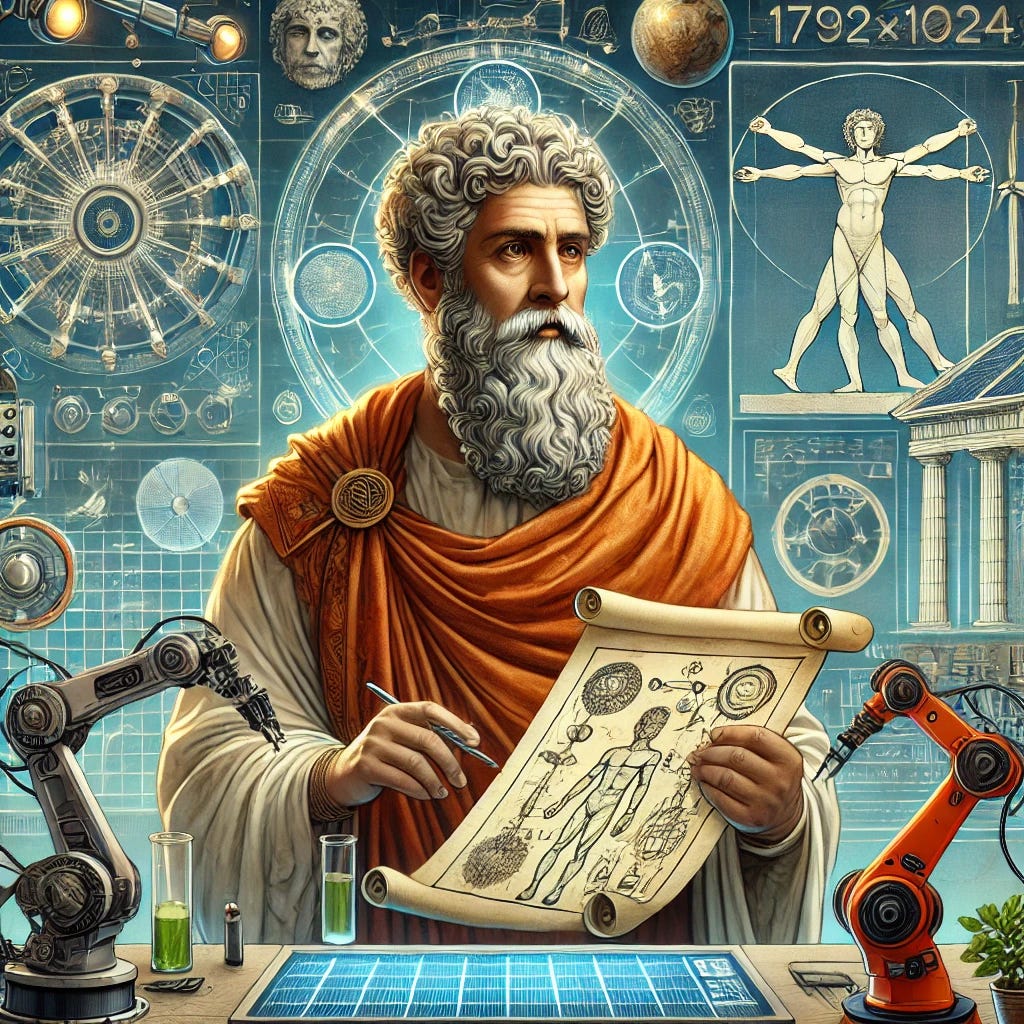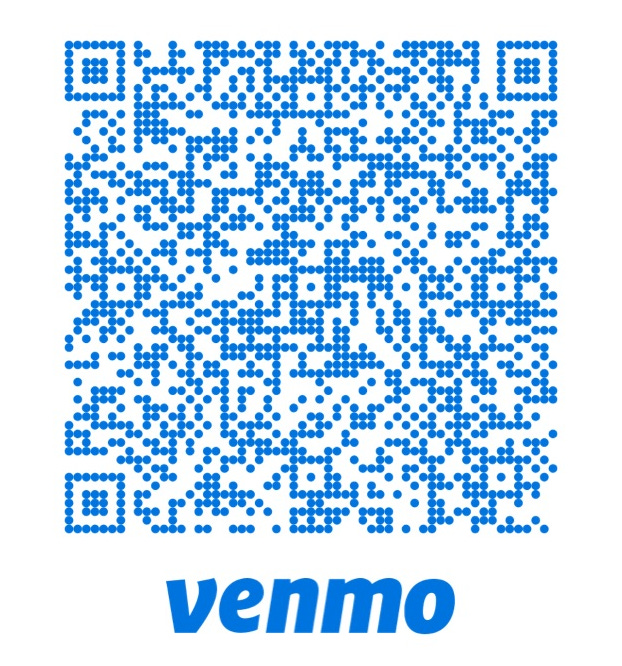Heron of Alexandria: Ancient Genius Meets Modern Innovation
Past Forward: Historical Icons in the Digital Frontier #40
Voice-over provided by Amazon Polly
Also, check out Eleven Labs, which we use for all our fiction.
Preface
Welcome to the fortieth entry in our ongoing series, Past Forward: Historical Icons in the Digital Frontier. This series explores how history’s most influential figures might interact with the modern world, imagining how their talents and insights could influence contemporary society. In this installment, we bring Heron of Alexandria—the brilliant ancient inventor and mathematician known for creating the world’s earliest steam-powered device—into the 21st century. Imagine Heron stepping into today’s world of robotics, automation, and renewable energy, where his mechanical genius finds endless potential. How would Heron respond to modern technologies that build on his foundational concepts? Let us accompany Heron as he delves into the landscape of robotics and energy, leaving an indelible mark on how we perceive invention, sustainability, and the power of human ingenuity.
Introduction
Heron of Alexandria stands in awe as he enters a bustling robotics lab filled with mechanical arms, sensors, and computers displaying complex simulations. For the first time in nearly two millennia, he is reunited with machines—though of a variety far beyond anything he had created. In his own era, Heron was a celebrated inventor, famed for his aeolipile, the first known steam-powered device, which spun on its axis when heated. This rudimentary steam engine fascinated his peers but, in his time, was seen largely as a marvel, a curiosity, rather than a tool with world-changing potential.
Now, surrounded by robots that can mimic human movement, automation systems that control entire factories, and energy sources that harness the power of the sun and wind, Heron feels a profound excitement. The principles that had once shaped his creations are now the very foundation of a world transformed. Driven by insatiable curiosity, Heron prepares to explore the fields of robotics, automation, and renewable energy, determined to understand how his ancient ideas have evolved—and to see how his genius might find new expression in the age of advanced technology.
Rediscovering Mechanics in the Age of Robotics
Heron’s journey begins with a visit to a robotics laboratory, where engineers introduce him to modern mechanical systems. They explain the basics of servo motors, sensors, and algorithms that enable robots to perform tasks once reserved for humans. Heron is immediately struck by the parallels to his own work in mechanics—he was, after all, one of the first to experiment with pneumatics and hydraulics, using air and water pressure to animate temple doors and theatrical displays.
As he examines the mechanisms of robotic limbs and watches as they manipulate objects with precision, Heron is reminded of his automated “puppets” and machines that could perform repetitive motions. While his devices were powered by simple forces like steam, weight, and gravity, these modern machines harness electricity, programmed intelligence, and finely tuned components that push the limits of motion and dexterity.
Inspired, Heron proposes a new approach to robotic movement. Drawing on his own knowledge of mechanics, he suggests integrating principles of balance and weight distribution to improve the efficiency of robotic arms. His ideas, though rooted in ancient techniques, offer fresh insights into reducing energy expenditure in robotic systems. Engineers are intrigued by his proposals, realizing that Heron’s mechanical intuition could open up innovative ways to optimize energy use, even in advanced robotics.
Automation and the Revival of Ancient Machines
Heron’s fascination with robotics naturally extends into the world of automation. As he tours a modern manufacturing facility, he marvels at the seamless choreography of automated assembly lines, where machines work in perfect harmony, guided by pre-programmed routines. Heron is especially intrigued by the use of conveyor belts, automated sorting systems, and robotic welders—all components that perform repetitive tasks with precision.
Reflecting on his own inventions, Heron recalls the automated machines he developed for temples, such as the self-operating doors and coin-operated devices. He sees in modern automation the realization of his vision—a world where machines perform complex tasks autonomously. Fascinated by the idea of programmable machines, he collaborates with engineers to explore ways of reviving some of his ancient concepts in today’s automation technology.
One such project involves developing a contemporary version of his “automatic theater,” a machine that used strings, pulleys, and counterweights to stage elaborate plays. Working with robotics experts, Heron adapts this concept into a programmable showcase, using automated actuators and sensors to create a demonstration of mechanical storytelling. The result is a modern “Heronian Theater” that showcases the timeless appeal of engineering, capturing audiences and demonstrating that even ancient ideas have a place in modern technology.
The Potential of Steam Reimagined: Exploring Modern Energy Sources
Moving from automation to energy, Heron learns that his beloved steam, once a force limited to powering small contraptions, is now used to generate massive amounts of electricity in power plants. Yet even more impressive to him are the new methods of energy generation: solar panels, wind turbines, and nuclear reactors. Heron is fascinated by the sheer scale of these technologies, which draw from natural forces to power entire cities.
He watches as engineers explain solar cells, which convert sunlight directly into electricity. Heron immediately sees parallels to his work with the aeolipile, his steam-powered device that harnessed heat to produce motion. Inspired, he works with renewable energy experts to develop a modern interpretation of his steam engine, exploring how his principles could be applied to low-cost, small-scale energy solutions for rural or off-grid areas.
Heron’s passion for experimentation leads him to propose a “micro-steam turbine” designed to be both portable and efficient, ideal for remote locations where conventional power sources are unavailable. This modernized steam turbine, though far smaller than its industrial counterparts, becomes a testament to Heron’s legacy as an innovator, reminding the engineers that sometimes, even ancient methods have relevance in a modern context. The prototype generates interest, especially among humanitarian engineers looking for sustainable, low-cost energy solutions in developing regions.
Artificial Intelligence and the Philosophy of Automation
As Heron delves deeper into the world of robotics and automation, he encounters the concept of artificial intelligence. At first, he is skeptical. The idea that a machine could “think” seems antithetical to the mechanical simplicity he knew. Yet as engineers demonstrate AI-driven robots that adapt, learn, and even “make decisions,” Heron is forced to confront a new frontier of automation—one where machines are no longer mere tools but partners in discovery.
Curious about the implications, Heron meets with AI researchers to discuss the ethical and philosophical dimensions of intelligent machines. He is reminded of ancient debates in Alexandria, where scholars questioned the nature of life, intelligence, and purpose. Heron, who saw machines as extensions of human ingenuity, struggles to understand the implications of machines that operate independently of human intention. He worries about the risks of placing too much power in the hands of devices that lack a human soul or conscience.
Nevertheless, Heron begins to appreciate AI’s potential to enhance human capabilities. He collaborates with researchers to explore ways in which AI can optimize energy usage in automated systems, applying his understanding of mechanics to create algorithms that prioritize efficiency without compromising function. Through this process, Heron discovers a new role for himself—not only as a creator of machines but as a bridge between ancient principles of mechanics and modern philosophies of artificial intelligence.
From Inventor to Innovator: Embracing a Legacy of Sustainable Design
Throughout his journey, Heron becomes increasingly committed to the concept of sustainable design. He is deeply moved by the idea of developing technologies that benefit society without depleting resources or harming the environment. In his own time, Heron’s devices were marvels of engineering that sparked joy and wonder, but they were limited by the materials and energy sources available. Now, he sees a future where machines serve not only as conveniences but as tools for building a sustainable world.
Inspired, Heron works on a final project—a blueprint for a self-sustaining machine that uses renewable energy to power itself indefinitely. Drawing on his knowledge of steam and modern advancements in solar and wind power, he designs a prototype for an “eternal machine,” one that could theoretically run without external input, relying solely on environmental forces. The design becomes a symbol of Heron’s legacy: an enduring testament to the power of innovation and a reminder that technology, when guided by purpose, can contribute to the well-being of both humanity and the planet.
Conclusion: Heron of Alexandria’s Timeless Influence
As Heron prepares to return to his own era, he reflects on the vast technological journey he has witnessed. He has seen his own ideas taken to unimaginable heights, transforming from rudimentary inventions into the sophisticated machines that define the modern world. In robotics, automation, and energy, Heron has discovered a continuum that connects ancient knowledge to modern wisdom—a reminder that invention is not bound by time but by imagination.
Heron departs the 21st century with a sense of fulfillment, knowing that his legacy lives on in the machines that power, build, and sustain society. His journey through robotics and energy has rekindled his belief in the potential of human ingenuity, a potential he once harnessed to amuse and amaze but now understands as a force for progress and sustainability.
As he returns to Alexandria, Heron leaves behind a blueprint of inspiration, a reminder that even the simplest ideas can shape the future. His final reflections are ones of gratitude and hope, as he realizes that the spirit of invention—his spirit—continues to thrive, adapting to meet the challenges of each new era.
Thank you for your time today. Until next time, stay gruntled.
Do you like what you read but aren’t yet ready or able to get a paid subscription? Then consider a one-time tip at:
https://www.venmo.com/u/TheCogitatingCeviche
Ko-fi.com/thecogitatingceviche








Conrad, this is a wonderful exploration into what Heron, clearly an extraordinary mind in his own time, might bring to the modern world. You do a great job of imagineering how it might occur. I learn so much from your series. Thank you.